Research on Damage and Deterioration of Fiber Concrete under Acid Rain Environment Based on GM(1,1)-Markov
Abstract
:1. Introduction
2. Materials and Methods
2.1. Materials and Mixture Proportions
2.2. Experimental Methods
2.3. Testing Procedure
3. Results and Discussion
3.1. Evaluation Parameters of Compressive Strength
3.2. Evaluation Parameters of Relative Mass
3.3. Evaluation Parameters of Relative Dynamic Elastic Modulus
3.4. Microstructure Investigation
3.5. Pore Structure
3.6. Microhardness Analysis
4. GM(1,1)-Markov Prediction Model
4.1. Derivation of the GM(1,1)-Markov Model
4.2. Analysis of Prediction Result
5. Conclusions
- (1)
- Incorporation of steel fibers and basalt fibers can play an inhibiting role in the deterioration of damage to concrete under the effect of acid rain corrosion. The best effect is achieved when the volume dose of SF is 2% and the volume dose of BF is 0.1%.
- (2)
- The microscopic test results show that the fibers share the expansion stress caused by corrosion products to a certain extent, improve the pore structure, reduce the thickness of ITZ, make the concrete micro-structure more dense, and enhance the resistance to acid rain corrosion.
- (3)
- The GM(1,1)-Markov model has a high prediction accuracy and can effectively predict the damage deterioration trend of fiber concrete, which provides a good theoretical basis for the repair and reinforcement of concrete in acid rain areas.
Author Contributions
Funding
Institutional Review Board Statement
Informed Consent Statement
Data Availability Statement
Conflicts of Interest
References
- Zhou, Y.; Zheng, S.; Chen, L.; Long, L.; Wang, B. Experimental investigation into the seismic behavior of squat reinforced concrete walls subjected to acid rain erosion. J. Build. Eng. 2021, 44, 102899. [Google Scholar] [CrossRef]
- Zhou, C.; Zhu, Z.; Zhu, A.; Zhou, L.; Fan, Y.; Lang, L. Deterioration of mode II fracture toughness, compressive strength and elastic modulus of concrete under the environment of acid rain and cyclic wetting-drying. Constr. Build. Mater. 2019, 228, 116809. [Google Scholar] [CrossRef]
- Fan, Y.F.; Hu, Z.Q.; Zhang, Y.Z.; Liu, J.L. Deterioration of compressive property of concrete under simulated acid rain environment. Constr. Build. Mater. 2010, 24, 1975–1983. [Google Scholar] [CrossRef]
- Chen, M.-C.; Wang, K.; Xie, L. Deterioration mechanism of cementitious materials under acid rain attack. Eng. Fail. Anal. 2013, 27, 272–285. [Google Scholar] [CrossRef]
- Shi, L.A.; Ma, H.Y.; Ke, K. Concrete’s resistance to acide rain and its mechanism. J. Nanjing Univ. Sci. Technol. 2012, 36, 717–723. [Google Scholar] [CrossRef]
- Ahmad, I.A.; Parung, H. Durability of Concrete Using Rice Husk Ash as Cement Substitution Exposed To Acid Rain. Int. J. Eng. Res. Appl. 2014, 4, 144–149. [Google Scholar]
- Wang, K.; Ma, B.G.; Zhang, H.Y. Effect of mineral admixtures on deterioration of concrete under acid rain attack. J. Build. Mater. 2013, 16, 416–421. [Google Scholar] [CrossRef]
- Xu, K.C.; Zhang, Z.X.; Yang, L.S.; Chen, M.C.; Nie, X. Experimental research on lithium slag reinforced concrete short columns under axial compression and simulated acid rain corrosion. Build. Struct. 2019, 49, 64–69. [Google Scholar] [CrossRef]
- Niu, D.T.; Wang, J.B.; Ma, X. Sulfate attack test of shotcrete under dry-wet alternation. China J. Highw. Transp. 2016, 29, 82–89. [Google Scholar]
- Wang, Y.; Niu, D.T.; Song, Z.P. Effect of Acid Rain corrosion on Steel Fiber Reinforced Concrete. J. Wuhan Univ. Technol. (Mater. Sci.) 2017, 32, 121–128. Available online: https://link.springer.com/article/10.1007%2Fs11595-017-1569-y (accessed on 10 September 2021). [CrossRef]
- Zollo, R.F. Fiber-reinforced concrete: An overview after 30 years of development. Cem. Concr. Compos. 1997, 19, 107–122. [Google Scholar] [CrossRef]
- Zhang, C.; Wang, L.; Zhang, X.; Ding, Y. A 3-dimensional prediction model for mechanical strength of basalt-steel fiber-reinforced recycled aggregate concrete based on reaction surface method. Constr. Build. Mater. 2021, 303, 124376. [Google Scholar] [CrossRef]
- Koksal, F.; Yıldırım, M.S.; Benli, A.; Gencel, O. Hybrid effect of micro-steel and basalt fibers on physico-mechanical properties and durability of mortars with silica fume. Case Stud. Constr. Mater. 2021, 15, e00649. [Google Scholar] [CrossRef]
- Ibrahim, A.I.; Wu, G.; Sun, Z.-Y. Experimental Study of Cyclic Behavior of Concrete Bridge Columns Reinforced by Steel Basalt-Fiber Composite Bars and Hybrid Stirrups. J. Compos. Constr. 2017, 21, 04016091. [Google Scholar] [CrossRef]
- Liu, K.; Xu, P.; Wang, F.; Jin, C.; Liu, Q.; Pang, H.; Xie, H. The accumulated stress damage and residual life prediction of unreinforced concrete pavement with electric heating pipes. Constr. Build. Mater. 2021, 278, 122258. [Google Scholar] [CrossRef]
- Srikanth, I.; Arockiasamy, M. Deterioration models for prediction of remaining useful life of timber and concrete bridges: A review. J. Traffic Transp. Eng. (Engl. Ed.) 2020, 7, 152–173. [Google Scholar] [CrossRef]
- Ekolu, S.O. Model for natural carbonation prediction (NCP): Practical application worldwide to real life functioning concrete structures. Eng. Struct. 2020, 224, 111126. [Google Scholar] [CrossRef]
- Moradllo, M.K.; Sadati, S.; Shekarchizadeh, M. Quantifying maximum phenomenon in chloride ion profiles and its influence on service-life prediction of concrete structures exposed to seawater tidal zone—A field oriented study. Constr. Build. Mater. 2018, 180, 109–116. [Google Scholar] [CrossRef]
- Serralheiro, M.I.; de Brito, J.; Silva, A. Methodology for service life prediction of architectural concrete facades. Constr. Build. Mater. 2017, 133, 261–274. [Google Scholar] [CrossRef]
- JGJ/T 221-2010. Technical Specification for Application of Fiber Reinforced Concrete; MOHRUD: Beijing, China, 2010.
- GB/T 50476-2019. Standard for Design of Concrete Structure Durability; AQSIQ: Beijing, China, 2019.
- Cheng, H.; Liu, T.; Zou, D.; Zhou, A. Compressive strength assessment of sulfate-attacked concrete by using sulfate ions distributions. Constr. Build. Mater. 2021, 293, 123550. [Google Scholar] [CrossRef]
- Taqi, F.Y.; Mashrei, M.A.; Oleiwi, H.M. Experimental study on the effect of corrosion on shear strength of fibre-reinforced concrete beams. Structures 2021, 33, 2317–2333. [Google Scholar] [CrossRef]
- Poorsaheli, H.B.; Behravan, A.; Aghda, S.T.T. Durability performance of hybrid reinforced concretes (steel fiber + polyolefin fiber) in a harsh marine tidal zone of Persian Gulf. Constr. Build. Mater. 2021, 266, 121176. [Google Scholar] [CrossRef]
- Aydın, S.; Baradan, B. Sulfate resistance of alkali-activated slag and Portland cement based reactive powder concrete. J. Build. Eng. 2021, 43, 103205. [Google Scholar] [CrossRef]
- Bankir, M.B.; Sevim, U.K. Performance optimization of hybrid fiber concretes against acid and sulfate attack. J. Build. Eng. 2020, 32, 101443. [Google Scholar] [CrossRef]
- Dong, R.X.; Shen, X.D.; Xue, H.J.; Liu, Q.; Wei, L.S. Sulfate durability of aeolian sand concrete under dry-wet cycles and sand blowing. Mater. Rep. 2020, 34, 20053–20060. Available online: https://www.cnki.com.cn/Article/CJFDTOTAL-CLDB202020011.htm (accessed on 11 September 2021).
- Gao, L.; Adesina, A.; Das, S. Properties of eco-friendly basalt fibre reinforced concrete designed by Taguchi method. Constr. Build. Mater. 2021, 302, 124161. [Google Scholar] [CrossRef]
- Canbazoglu, F.M.; Fan, B.; Kargar, A.; Vemuri, K.; Bandaru, P.R. Enhanced solar evaporation of water from porous media, through capillary mediated forces and surface treatment. AIP Adv. 2016, 6, 085218. [Google Scholar] [CrossRef]
- Meng, J.; Zhong, J.; Xiao, H.; Ou, J. Enhancement of strength and ductility of cement-based composites by incorporating silica nanoparticle coated polyvinylalcohol fibers. AIP Adv. 2019, 9, 065108. [Google Scholar] [CrossRef] [Green Version]
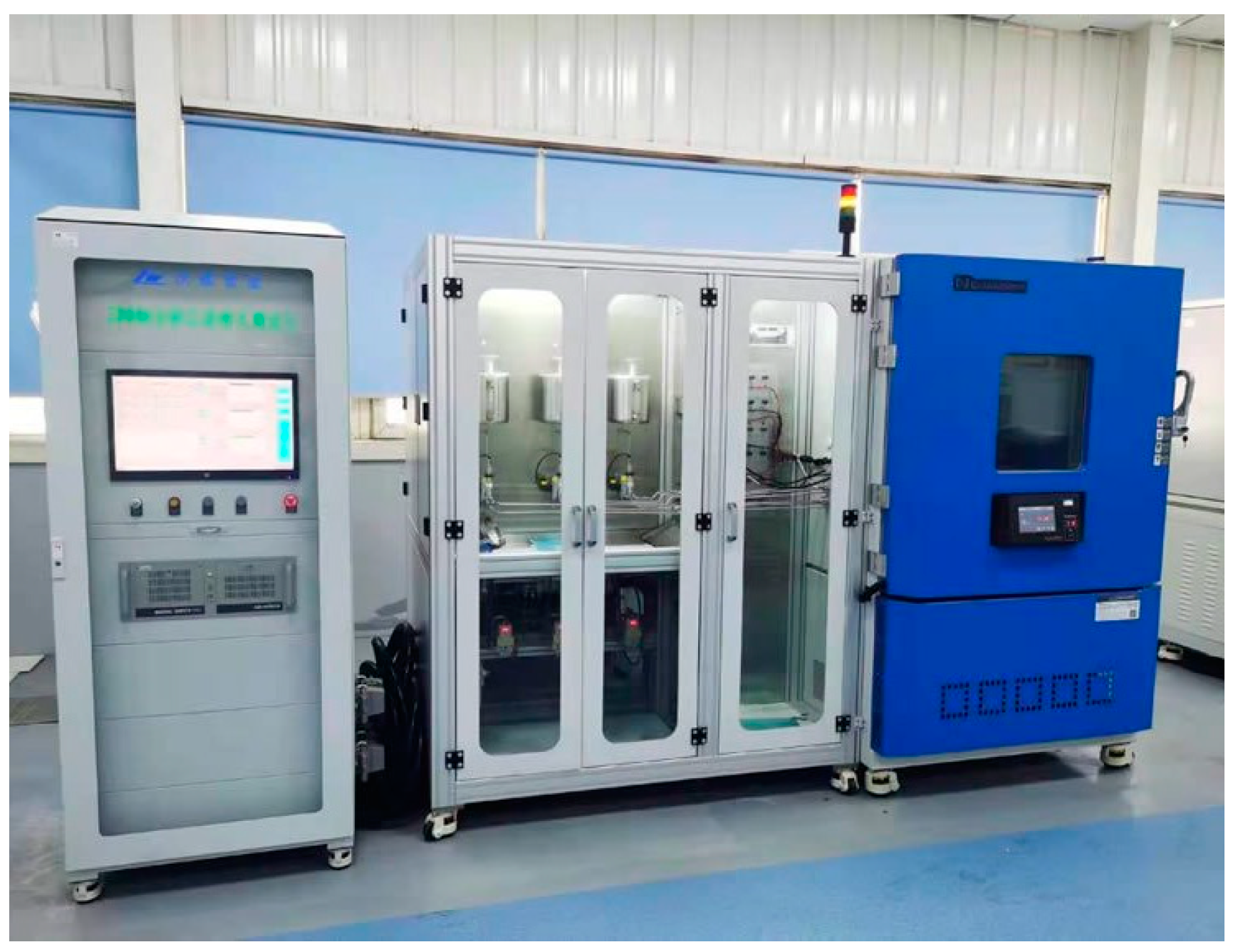
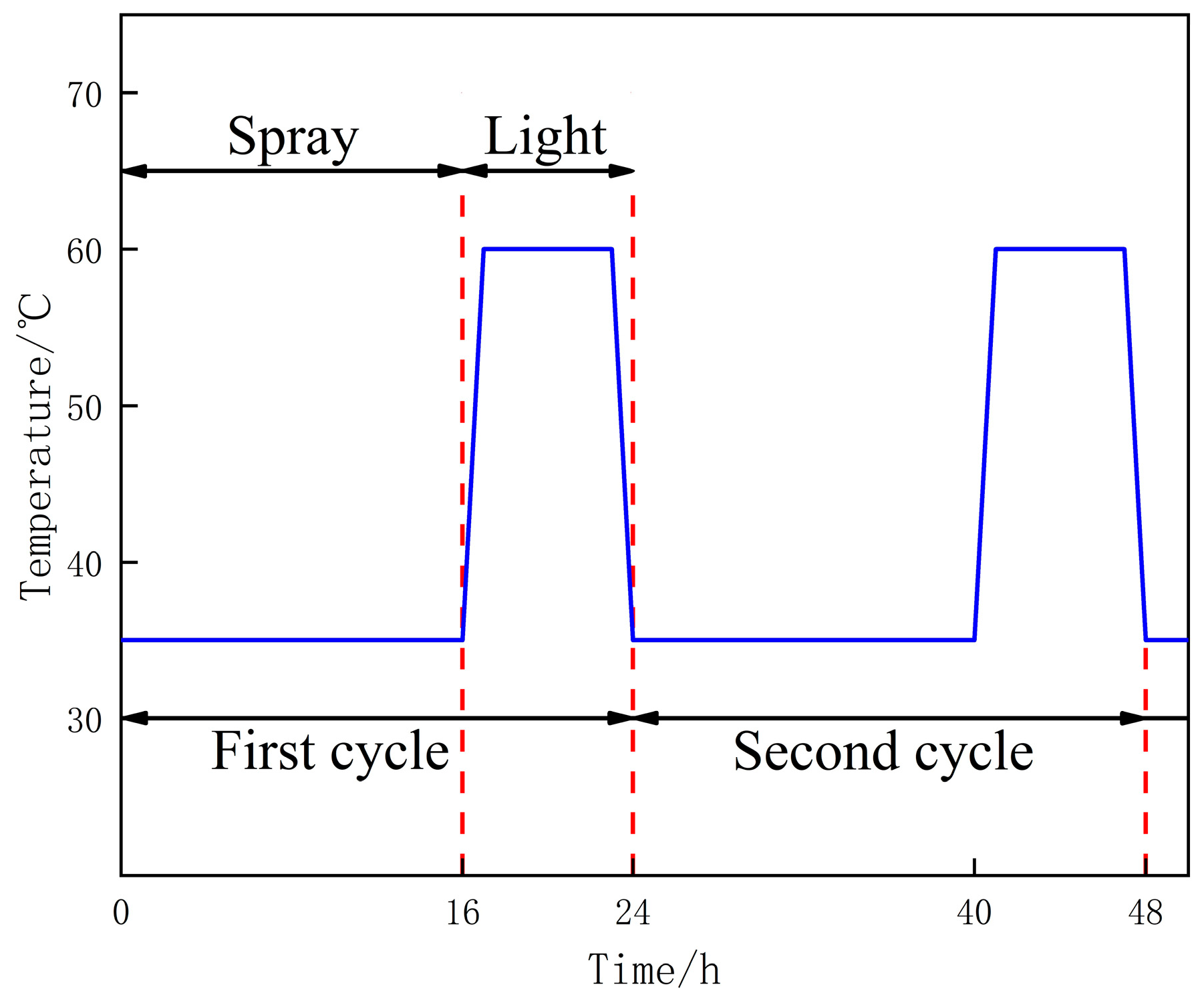



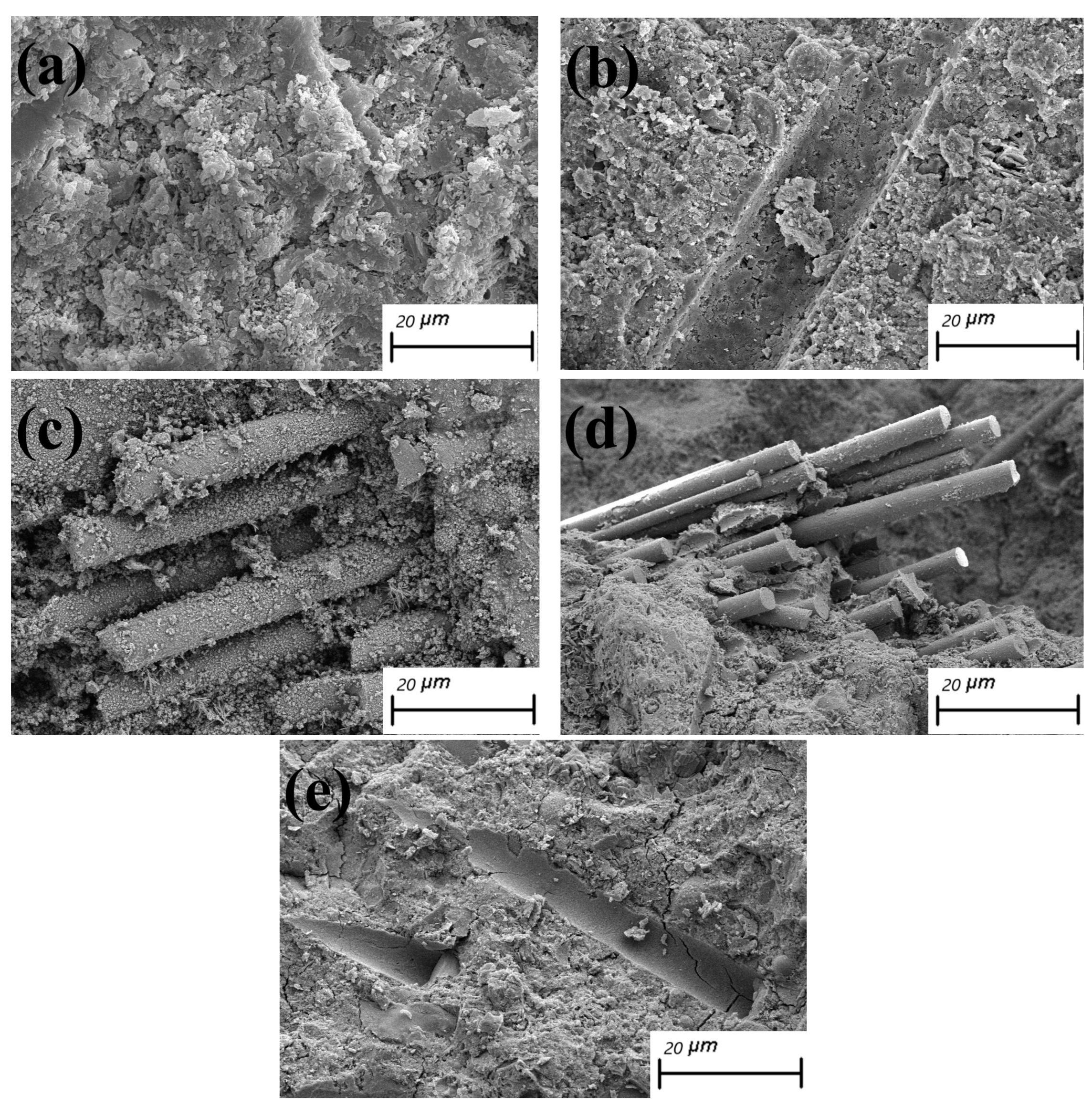
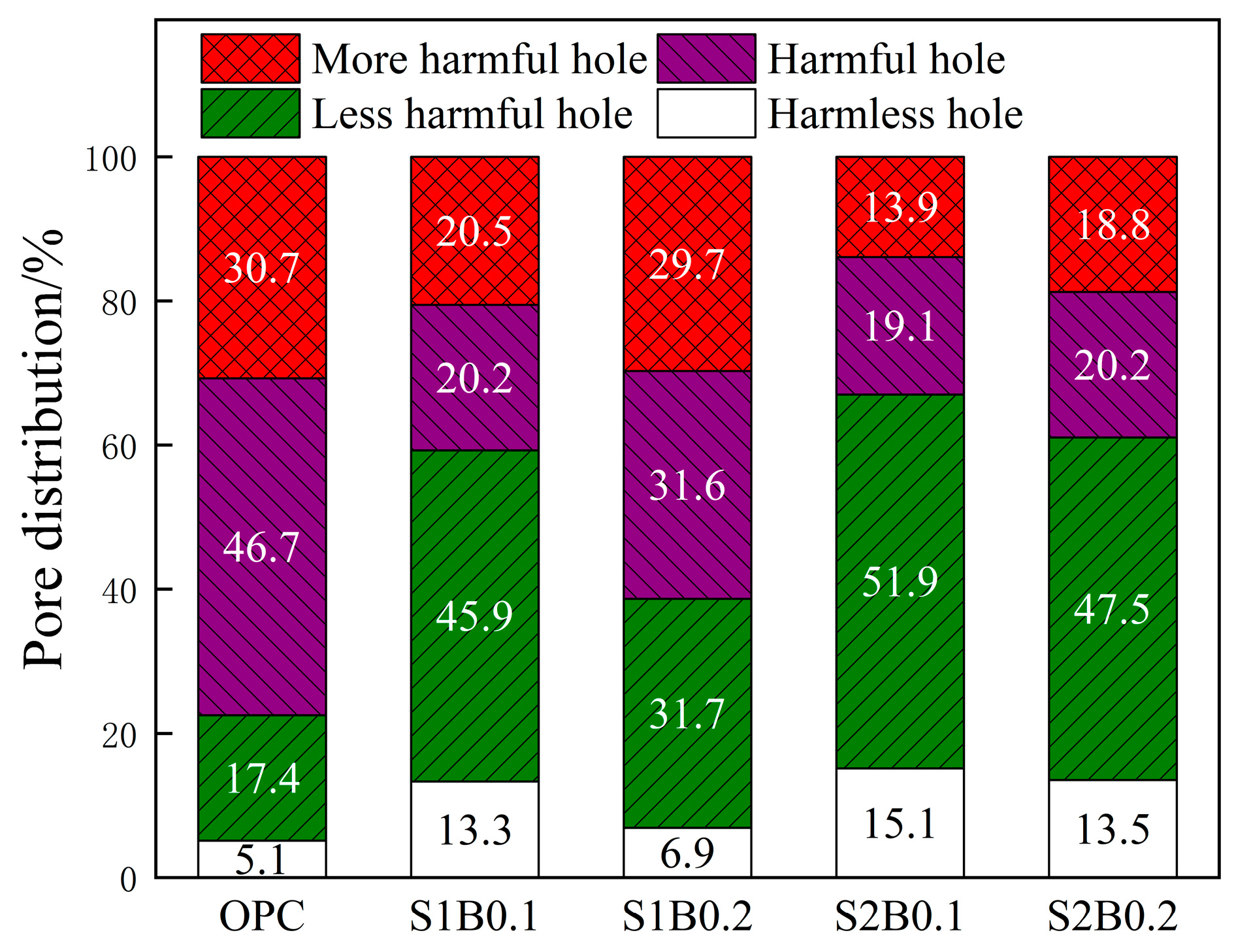


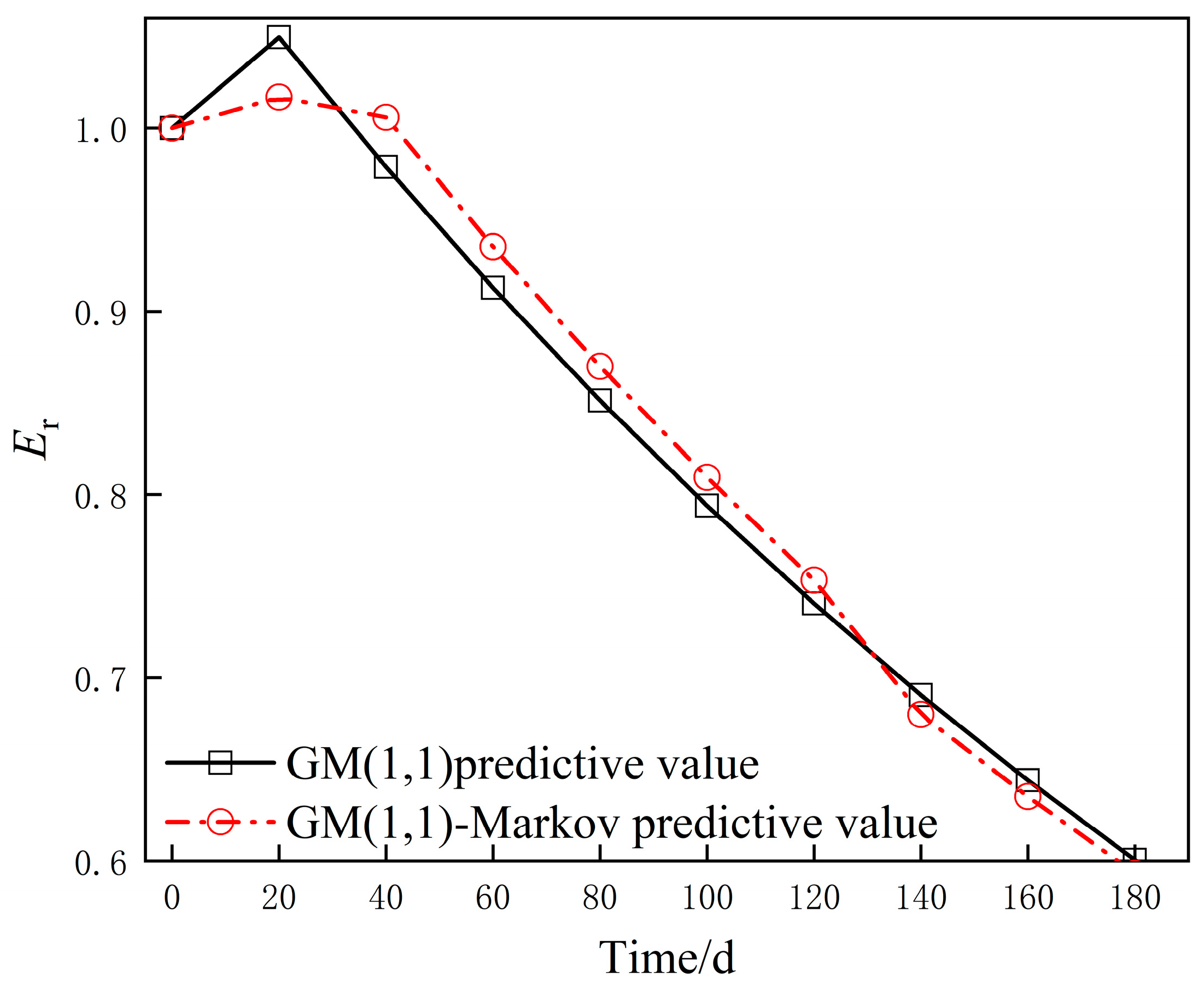

| Material | Al2O3 | CaO | K2O | IL | MgO | MnO | SO3 | Fe2O3 | SiO2 |
|---|---|---|---|---|---|---|---|---|---|
| Cement | 9.2 | 50.5 | 1.2 | 1.8 | 3.3 | 0.3 | 2.1 | 4.2 | 26.5 |
| Fly ash | 31.2 | 6.0 | 1.5 | 2.2 | 1.1 | 0.2 | 0.6 | 6.5 | 48.5 |
| Type | Length/mm | Diameter/μm | Elastic Modulus/GPa | Tensile Strength/MPa | Density/kg·m−3 | Shape |
|---|---|---|---|---|---|---|
| SF | 30 | 500 | 200 | 1270 | 7800 | Wavy |
| BF | 12 | 20 | 100 | 4500 | 2700 | Monofilament dispersion |
| Mix | OPC | S1B0.1 | S1B0.2 | S2B0.1 | S2B0.2 |
|---|---|---|---|---|---|
| Cement/(kg·m−3) | 400 | 400 | 400 | 400 | 400 |
| Sand/(kg·m−3) | 633 | 633 | 633 | 633 | 633 |
| Stone/(kg·m−3) | 1167 | 1167 | 1167 | 1167 | 1167 |
| Water/(kg·m−3) | 200 | 200 | 200 | 200 | 200 |
| Fly ash/(kg·m−3) | 100 | 100 | 100 | 100 | 100 |
| Superplasticizer/(kg·m−3) | 0.65 | 0.65 | 0.65 | 0.65 | 0.65 |
| SF/% (by volume fraction) | / | 1.0 | 1.0 | 2.0 | 2.0 |
| BF/% (by volume fraction) | / | 0.1 | 0.2 | 0.1 | 0.2 |
| Compressive strength/MPa | 44.2 | 48.3 | 47.9 | 51.2 | 48.5 |
| pH Value | H+ | SO42− | NH3+ | NO3− |
|---|---|---|---|---|
| 3.0 | 1.0 × 10−3 | 1.37 × 10−3 | 2.0 × 10−4 | 1.0 × 10−3 |
| Time/d | Raw Data | GM(1,1) | P(x) | GM(1,1)-Markov | |||
|---|---|---|---|---|---|---|---|
| Fitting Value | Relative Error | Fitting Value | Relative Error | ||||
| 0 | 1.0000 | 1.0000 | 0.00% | 0.0000 | + | 1.0000 | 0.00% |
| 20 | 1.0065 | 1.0496 | 4.28% | 0.0431 | - | 1.0169 | 1.03% |
| 40 | 0.9889 | 0.9788 | 1.02% | 0.0101 | + | 1.0059 | 1.72% |
| 60 | 0.9426 | 0.9128 | 3.16% | 0.0298 | + | 0.9353 | 0.78% |
| 80 | 0.8752 | 0.8513 | 2.73% | 0.0239 | + | 0.8699 | 0.60% |
| 100 | 0.7966 | 0.7939 | 0.33% | 0.0027 | + | 0.8094 | 1.61% |
| 120 | 0.7559 | 0.7404 | 2.05% | 0.0155 | + | 0.7532 | 0.36% |
| 140 | 0.6815 | 0.6905 | 1.32% | 0.0090 | - | 0.6799 | 0.24% |
| 160 | 0.6350 | 0.6439 | 1.41% | 0.0089 | - | 0.6351 | 0.02% |
| 180 | 0.5910 | 0.6005 | 1.61% | 0.0095 | - | 0.5932 | 0.38% |
Publisher’s Note: MDPI stays neutral with regard to jurisdictional claims in published maps and institutional affiliations. |
© 2021 by the authors. Licensee MDPI, Basel, Switzerland. This article is an open access article distributed under the terms and conditions of the Creative Commons Attribution (CC BY) license (https://creativecommons.org/licenses/by/4.0/).
Share and Cite
Yu, J.; Qiao, H.; Zhu, F.; Wang, X. Research on Damage and Deterioration of Fiber Concrete under Acid Rain Environment Based on GM(1,1)-Markov. Materials 2021, 14, 6326. https://doi.org/10.3390/ma14216326
Yu J, Qiao H, Zhu F, Wang X. Research on Damage and Deterioration of Fiber Concrete under Acid Rain Environment Based on GM(1,1)-Markov. Materials. 2021; 14(21):6326. https://doi.org/10.3390/ma14216326
Chicago/Turabian StyleYu, Jianqiao, Hongxia Qiao, Feifei Zhu, and Xinke Wang. 2021. "Research on Damage and Deterioration of Fiber Concrete under Acid Rain Environment Based on GM(1,1)-Markov" Materials 14, no. 21: 6326. https://doi.org/10.3390/ma14216326
APA StyleYu, J., Qiao, H., Zhu, F., & Wang, X. (2021). Research on Damage and Deterioration of Fiber Concrete under Acid Rain Environment Based on GM(1,1)-Markov. Materials, 14(21), 6326. https://doi.org/10.3390/ma14216326






